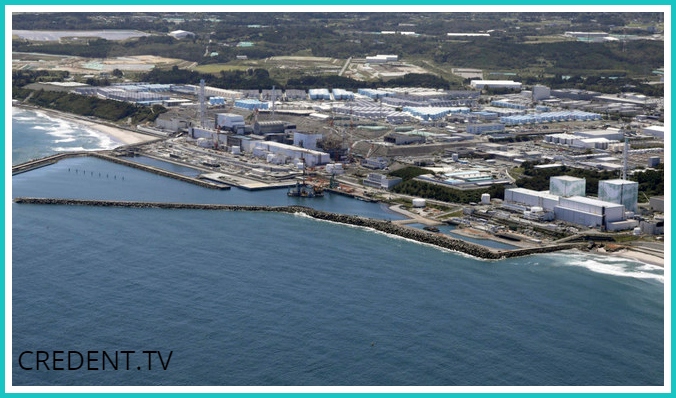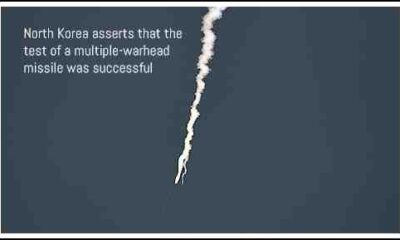China
Japan begins discharging radioactive seawater
Published
11 months agoon

Why are the people of China and South Korea afraid of the discharge of 133 crore litres of water over the next 30 years?
Japan started discharging radioactive water into the Pacific Ocean from the Fukushima nuclear reactor. This procedure began at 1:03 p.m. local time in Japan. According to the Japan Times, on the first day, 2 lakh litres of water will be released. The capacity would thereafter be raised to 4.60 lakh litres.
The nuclear plant’s maintenance organisation, TEPCO, reported that first of all, a sample of water was leaked from the initial tank. Before and after this, every circumstance was examined. There were no issues with it. For 24 hours, the plant’s pump will continue to release water.
A horrific explosion occurred at the Fukushima Nuclear Plant in 2011 as a result of the earthquake and tsunami. There has since accumulated 133 crore litres of radioactive water. The amount of water that is kept there, according to the New York Times, is equivalent to 500 Olympic-sized swimming pools. The moment Japan mentioned putting this water in the sea, China and South Korea’s citizens began to fear for their lives.
The origin of 133 billion litres of radioactive water is unknown.
Japan had a 9.1 magnitude earthquake at 3.42 am on March 11. As a result, the sea layer began to slide, which caused the tsunami. The Fukushima nuclear power plant’s reactors were immediately shut down as soon as the vibrations were felt. In order to cool the reactor, generators were initiated. Water reached the plant before the backup generator could cool the overheated reactor.
Following this, the emergency generator was turned off, which led to the hot reactor melting down.
After a while, the nuclear power station began experiencing horrific explosions. It was kept cool for several months after that with 133 crore litres of sea water to stop nuclear reactor chain reactions.
This made 64 different kinds of radioactive substances dissolved in the water. Such elements that are dangerous to humans include Carbon-14, Iodine-131, Cesium-137, Strontium-90 Cobalt, Hydrogen-3, and Tritium.
The majority of these radioactive substances have extremely brief lifetimes. As a result, their impact has faded. However, other substances, like carbon-14, take 5000 years to decompose. The water in nuclear reactors still contains tritium particles.
After Japan released radioactive water, the world reacted.
If radioactive material is left behind, China and South Korea are concerned that it may get into people’s bodies through seafood like fish, crab, and sea critters. Tritium does not hurt when it touches the skin, but if it gets inside the body, it can raise the chance of illnesses like cancer. Seafood from Japan cannot be imported into China or Hong Kong. The Student Union of South Korea attempted to snoop about the Japanese Embassy in Seoul at the same time. There have been several student detentions. China has said that Japan is to blame for the globe becoming dangerous.
How long will radioactive material’s effects last?
The idea to release radioactive water into the sea has been approved by the UN’s nuclear body, IAEA. ALPS is the method that must be followed in order to release the radioactive material. Only once the process is finished is radioactive water allowed to enter the ocean. The water stored in 1,000 tanks won’t be released all at once, but over the course of 30 years. Daily mixing of 5 lakh litres of radioactive water into the ocean is the goal.
Aljazeera’s report states that this is being done to lessen its impact on the sea. Fishing is currently prohibited up to three kilometres from the location of the water release.
A scientist from Richmond claimed on the science-related website Nature that a 3 km fishing limit would have no effect. This is due to the extensive travel required for marine life. Other large fish that travel deep into the ocean will consume the fish in this location. Radioactive particles can easily enter the human body if these fish are consumed by the general public through marine food firms.
Richmond claims that it is extremely challenging to predict how long the effects of this radioactive water would continue. Additionally, it can have a protracted effect. Additionally, Mark Foreman, a nuclear chemistry professor in Sweden, claims that radiation’s impact on marine life will be minimal.
In Japan, a patient who was exposed to radioactive material shed bloody tears.
In Japan’s Tokaimura Nuclear Plant, an accident occurred 20 years ago. A technician working there was exposed to the most radiation in the world as a result of this catastrophe. Hisashi Ouchi, a 35-year-old man by that name, was the individual in question.
One day, Hisashi was assisting a coworker who was installing uranium in a nuclear power plant. Hisashi and his coworkers were directed to manually pump uranium into nuclear plants instead of using hydraulic pumps in order to save money. One of his errors caused gamma and neutron radiation to spread there. Following this, he experienced physical aches, nausea, and difficulties breathing.
Read also:-Medical checkup at DAV Jaipur
Hisashi was delivered right away to the University of Tokyo Medical Centre. The physicians were startled to discover that Hisashi’s body was completely devoid of white blood cells after inspecting him. The immune system of the human body is only maintained by white blood cells.
Radiation caused burns all over his body. He had blood dripping from his eyes. The physicians discovered that Hisashi had received 1700 rams’ worth of radiation during the course of his treatment. This radiation is twice as powerful as what would be needed to kill a person.
With the help of stem cells and blood transfusions, doctors were able to keep him alive, but his pain was getting worse every day. He repeatedly shouted that he was unable to continue taking the stem cells and that this was not an experiment.
He suffered three heart attacks on the 59th day of his hospital stay, but each time the doctors were able to save him. After 83 days, he finally passed away. His body’s organs were no longer functioning.
The Marshall Islands nuclear test that happened 67 years ago still has an impact today.
The Marshall Islands in the Pacific Ocean were the site of 67 nuclear tests carried out by the US between 1946 and 1958. 3.1 million cubic feet of radioactive soil and waste from the nuclear test have been kept under a dome on Runit Island.
Large pits have formed in the islands as a result of the nuclear test. A UN report from 2012 states that the results of testing are still being evaluated. Cancer and birth problems are being brought on by radiation in the Marshall Islands. The prevalence of both drug abuse and suicide is rising in this community.
It has caused them problems. For the security of their future generations, many activists in this area are fighting. Lenny Kramer, a female counsellor in Marshall, claims that many residents there were forced to flee their houses as a result of the nuclear test. This led to the loss of their culture and ancient practises, which had served as the identity of generations for thousands of years.
You may like
-


North Korea asserts that the test of a multiple-warhead missile was successful
-


The Student Wing of Congress storms the Exam Body NTA office and locks it from within
-


“During President Murmu’s address to Parliament, PM Modi was shown 73 times, and LoP Rahul Gandhi was shown six times”: Congress
-


NASA contracts Elon Musk’s SpaceX to deorbit the International Space Station in 2023.
-


A Caution For The CBI In The Delhi Court’s Arvind Kejriwal Custody Order
-


Bar Council of India requests that bar associations abstain from demonstrating in opposition to new criminal laws
